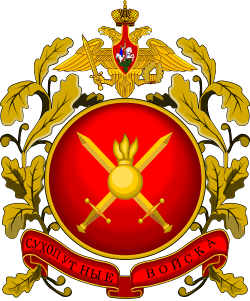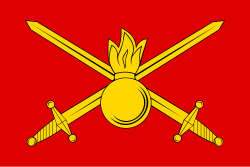俄羅斯陸軍
俄羅斯聯邦陸軍(俄語:Сухопутные войска Российской Федерации,羅馬化:Sukhoputnye voyska Rossiyskoy Federatsii)在1991年底蘇聯解體時成立,繼承蘇聯陸軍在俄羅斯的部隊,中途經過多次改革。
| 俄羅斯聯邦陸軍 Сухопутные войска Российской Федерации | |
|---|---|
  俄羅斯聯邦陸軍軍徽與軍旗 | |
| 存在時期 | 1991年12月至今 |
| 國家或地區 | |
| 效忠於 | |
| 部門 | |
| 種類 | 陸軍 |
| 規模 | 約780000人(540000 in Ukraine) |
| 直屬 | 俄羅斯聯邦國防部 |
| 參與戰役 | 塔吉克內戰 奧塞梯—印古什戰爭 1992年—1993年阿布哈茲戰爭 1993年俄羅斯憲政危機 第一次車臣戰爭 達吉斯坦戰爭 第二次車臣戰爭 俄格戰爭 北高加索叛亂 敘利亞內戰 頓巴斯戰爭 2022年俄羅斯入侵烏克蘭 |
| 指揮官 | |
| 現任指揮官 | 奧列格·薩柳科夫陸軍大將(2014年5月2日上任)[1] |
歷史
編輯蘇聯時期
編輯1917年11月7日,布爾什維克發動十月革命奪去了政權,1918年1月28日,蘇俄人民委員會組建了工農紅軍(俄語:Рабоче-Крестьянская Красная Армия,縮寫:РККА),在1918年間,工農紅軍先後參與了俄國內戰、波蘇戰爭、蘇芬戰爭、蘇德戰爭,為蘇維埃政權的鞏固與發展立下了巨大功勞。
1946年2月,工農紅軍及工農紅海軍更名為蘇聯武裝力量(俄語:Вооружённые Силы СССР),工農紅軍被改組為蘇聯陸軍與蘇聯空軍,蘇聯陸軍參與了鎮壓1956年匈牙利革命、1968年捷克斯洛伐克布拉格之春、蘇聯入侵阿富汗戰爭等行動。
俄羅斯聯邦時期
編輯1991年12月26日,蘇聯最高蘇維埃宣佈蘇聯不復存在[2],蘇聯正式解體,俄羅斯聯邦接管了蘇聯武裝力量的大部分,1992年5月7日,俄羅斯總統鮑里斯·葉利欽發佈命令,組建俄羅斯聯邦國防部和俄羅斯聯邦武裝力量,在1993年的憲政危機中,俄羅斯陸軍出動了坦克炮擊了俄羅斯人民代表大會所在地——白宮,迫使最高蘇維埃主席魯斯蘭·哈斯布拉托夫、俄羅斯副總統亞歷山大·魯茨科伊等人向俄羅斯總統鮑里斯·葉利欽投降。俄羅斯陸軍在1994年-1996年參與了第一次車臣戰爭,在1999年-2009年參與了第二次車臣戰爭。
1997年-2001年伊戈爾·德米特里耶維奇·謝爾蓋耶夫元帥擔任俄羅斯聯邦國防部長期間對俄羅斯陸軍進行了改革。弗拉基米爾·普京在他第一次擔任總統時也對俄羅斯陸軍進行了改革。2008年俄羅斯政府對軍隊進行了較大程度的改革,俄羅斯原來的6個軍區被改為4個:南部軍區、東部軍區、中央軍區、西部軍區[3],同時將「師」改為「旅」[4]。俄羅斯陸軍將由過去的「軍區—軍團—師—團」指揮模式改為「軍區—軍團—旅—營」的模式。
指揮結構
編輯在2008年的改革前,俄羅斯的軍區體制以陸軍為主體,在這種體制下,軍區只管得了陸軍,對海軍、空軍的約束很少,但是在改革後的體制下,軍區對軍區內海軍、空軍部隊的控制得以加強[5]。
| 俄羅斯軍區名稱及所轄軍團 | 指揮部所在地 |
|---|---|
| 西部軍區 | 聖彼得堡 |
| * 第1近衛坦克軍團 | 莫斯科州 |
| * 第6合成軍團 | 阿加拉托沃 |
| * 第20近衛合成軍團 | 沃羅涅日 |
| 南部軍區 | 頓河畔羅斯托夫 |
| * 第8近衛合成軍團 | 新切爾卡斯克 |
| * 第49合成軍團 | 斯塔夫羅波爾[來源請求] |
| * 第58近衛合成軍團 | 弗拉季高加索 |
| 中央軍區 | 葉卡捷琳堡 |
| * 第2近衛坦克軍團 | 薩馬拉 |
| * 第25合成軍團 | 葉卡捷琳堡 |
| * 陸軍第41軍團 | 新西伯利亞 |
| 東部軍區 | 哈巴羅夫斯克(伯力) |
| * 第5合成軍團 | 烏蘇里斯克(雙城子) |
| * 第29合成軍團 | 赤塔 |
| * 第35合成軍團 | 別洛戈爾斯克 |
| * 第36合成軍團 | 烏蘭烏德 |
裝備
編輯裝甲車
編輯- T-14阿瑪塔主戰坦克
- T-90主戰坦克
- T-80主戰坦克
- T-72主戰坦克
- T-62主戰坦克
- T-54/55主戰坦克
- BMP-3裝步戰車
- BMPT
- 2S25反坦克自走炮
- GAZ猛虎車
- VPK-7829步兵坦克
- 2S38 Derivatsiya-PVO自行式點防空車
飛機(現為空天軍所有)
編輯槍械及單兵武器
編輯火炮及防空武器
編輯- RPG-7
- RPG-18
- RPG-22
- RPG-26
- RPG-27
- RPG-28
- RPG-29
- RPG-30
- RPG-32
- RPO-A大黃蜂火箭筒
- 9K38針式便攜式防空導彈
- 9K333柳樹便攜式防空導彈
制服及單兵裝具
編輯註釋
編輯- ^ Главнокомандующий Сухопутными войсками Олег Салюков. Биография. 塔斯社. [2014年5月6日]. (原始內容存檔於2018年12月25日) (俄語).
- ^ 历史上的今天 12月26日. [2012-12-15]. (原始內容存檔於2013-01-28).
- ^ 俄罗斯拟将六大军区合并为四大军区. [2012-12-15]. (原始內容存檔於2010-10-12).
- ^ 盘点俄罗斯2009年军事改革 俄格冲突使俄加速改革. [2012-12-15]. (原始內容存檔於2013-04-25).
- ^ “新面貌”改革令俄军焕然一新. [2012-12-15]. (原始內容存檔於2020-04-30).
參考文獻
編輯- Arbatov, Alexei. Military Reform in Russia: Dilemmas, Obstacles, and Prospects. International Security (The MIT Press). 1998, 22 (4): 83–134. JSTOR 2539241. doi:10.2307/2539241.
- Austin, Greg & Muraviev, Alexey D. The Armed Forces of Russia in Asia. Tauris. 2001. ISBN 1-86064-485-6.
- Babakin, Alexander. Approximate Composition and Structure of the Armed Forces After the Reforms (31). Nezavisimoye Voyennoye Obozreniye (Independent Military Review). August 20–26, 2004.
- Baev, Pavel. The Russian Army in a Time of Troubles. Oslo: International Peace Research Institute. 1996. ISBN 0-7619-5187-3.
- Baumgardner, Neil. Russian Armed Forces Order of Battle. (原始內容存檔於2009-10-22).
- Butowsky, Piotr. Russia Rising. Air Forces Monthly. July 2007.
- Central Intelligence Agency. World Fact Book. 2006 [2022-01-21]. (原始內容存檔於2022-02-25).
- Dick, Charles. Russian Views on Future War, Part 3. Jane's Intelligence Review. November 1993.
- How are the mighty fallen. The Economist. 2005-06-30 [2022-01-21]. (原始內容存檔於2016-03-06).
- Fes'kov, V.I.; Golikov, V.I. & K.A. Kalashnikov. The Soviet Army In The Years Of The Cold War 1945–1991. Tomsk University Publishing House. 2004. ISBN 5-7511-1819-7.
- Finch, Raymond C. Why the Russian Military Failed in Chechnya. Fort Leavenworth, KS: Foreign Military Studies Office. (原始內容存檔於2006-10-15).
- Galeotti, Mark. Moscow's armed forces: a city's balance of power. Jane's Intelligence Review. February 1997.
- Giles, Keir. Military Service in Russia: No New Model Army (PDF). CSRC. May 2007 [2022-01-21]. (原始內容 (PDF)存檔於2021-12-31).
- Golts, Alexander. Military Reform in Russia and the Global War Against Terrorism. Journal of Slavic Military Studies. 2004, 17: 29–41. S2CID 154254640. doi:10.1080/13518040490440647.
- Herspring, Dale. Undermining Combat Readiness in the Russian Military 32 (4). Armed Forces & Society. July 2006.
- The Military Balance. International Institute for Strategic Studies. [2022-01-21]. (原始內容存檔於2013-01-19).
- Lenskii, A.G. & Tsybin, M.M. The Soviet Ground Forces in the Last Years of the USSR. St Petersburg: B&K Publishers. 2001.
- Lukin, Mikhail & Stukalin, Aleksander. Vsya Rossiyskaya Armiya. Moscow: Kommersant-Vlast. 14 May 2005.
- James H. Brusstar & Ellen Jones. McNair Paper 34, The Russian Military's Role in Politics. January 1995. (原始內容存檔於2008-01-14).
- Odom, William E. The Collapse of the Soviet Military. Yale University Press. 1998. ISBN 0-300-07469-7.
- Orr, Michael. The Russian Armed Forces as a factor in Regional Stability. CSRC. June 1998.
- Orr, Michael. Better or Just Not So Bad? An Evaluation of Russian Combat Performance in the Second Chechen War. CSRC. 2000.
- Orr, Michael. The Russian Ground Forces and Reform 1992–2002. 2003.
- Parchomenko, Walter. The State of Russia's Armed Forces and Military Reform. Parameters (Journal of the US Army War College). 1999–2000.
- Quartly, Alan. Miss Shooting Range crowned. BBC News. 8 March 2003 [2022-01-21]. (原始內容存檔於2008-11-23).
- Robinson, Colin. The Russian Ground Forces Today: A Structural Status Examination. Journal of Slavic Military Studies. 2005, 18 (2): 189–206. S2CID 145691472. doi:10.1080/13518040590944421.
- Schofield, Carey. Inside the Soviet Army. London: Headline. 1991. ISBN 0-7472-0418-7.
- Scott, Harriet Fast & Scott, William F. Russian Military Directories 2002 & 2004
- Suvorov, Viktor. Inside the Soviet Army. London: Macmillan. 1982. ISBN 0-586-05978-4.
- Turbiville, Graham H. Mafia in Uniform: The Criminalisation of the Russian Armed Forces. Fort Leavenworth: U.S. Army Foreign Military Studies Office. 1995.